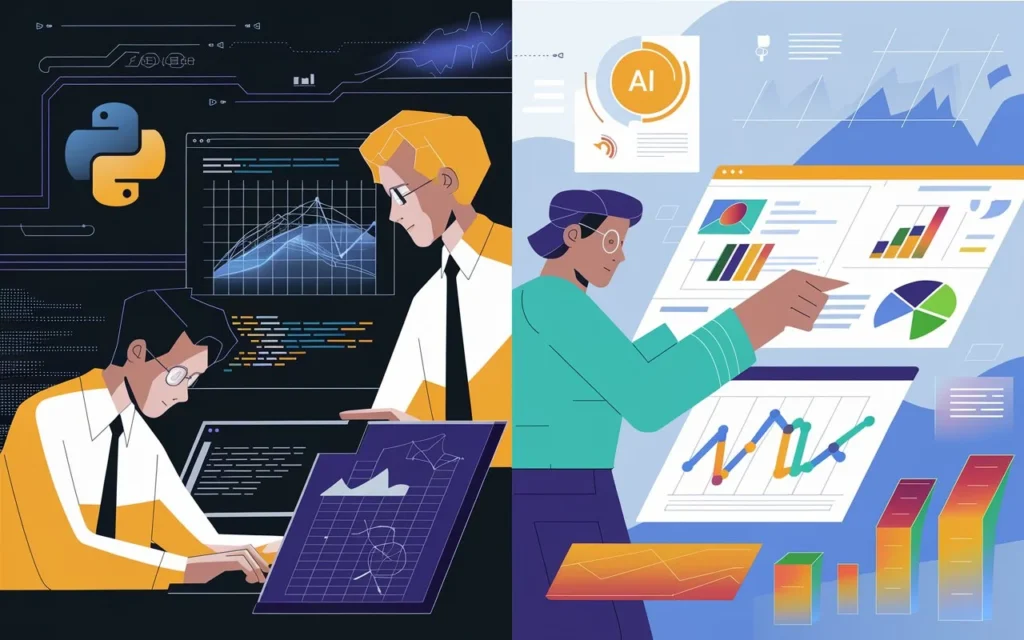
Data Science vs Data Analytics: What’s the Real Difference?
In the fast-evolving world of technology, data is the new oil—and professionals who can harness its potential are more in demand than ever. But as the data space grows, so does the confusion around terms like data science and data analytics. Are they one and the same? If you’re mining data from a massive dataset or building a sales forecast model, which hat are you wearing—a data scientist’s or a data analyst’s?
This isn’t just an academic distinction. Whether you’re a student mapping your career, a tech enthusiast brushing up your knowledge, or a professional exploring a new role, understanding the difference between data science and data analytics can guide your choices more effectively.
Are Data Science and Data Analytics the Same Thing?
You’ve probably seen these terms used interchangeably. After all, both deal with data—collecting it, processing it, and drawing conclusions. However, while they intersect at certain points, data science and data analytics are fundamentally different disciplines, with their own unique scopes, responsibilities, tools, and outcomes.
At a high level:
- Data science is the broader field—a multidisciplinary domain that involves using scientific methods, algorithms, and systems to extract knowledge and build predictive models.
- Data analytics is a subset—a specialised part of data science that focuses on examining datasets to uncover trends, draw conclusions, and support decision-making.
Let’s explore both in depth.
What is Data Science?
Data science is an umbrella term that encompasses a variety of processes and disciplines aimed at making sense of vast, complex datasets. It’s both an art and a science, and it combines mathematics, statistics, computer science, and domain expertise to solve high-level problems.
Typical Tasks in Data Science
- Mining large datasets to find patterns
- Creating and training machine learning models
- Developing AI-driven applications
- Experimenting with data to test hypotheses
- Automating decision-making processes
The Data Science Lifecycle
A key aspect of data science is that it follows a structured lifecycle—typically broken down into seven iterative phases:
- Problem Identification: Define a real-world challenge or opportunity.
- Data Mining: Extract relevant data from structured or unstructured sources.
- Data Cleaning: Remove inconsistencies, duplicates, and errors.
- Exploratory Data Analysis (EDA): Identify initial patterns and relationships.
- Feature Engineering: Select and transform variables using domain knowledge.
- Predictive Modelling: Use machine learning algorithms to forecast outcomes.
- Data Visualisation: Present insights using dashboards, charts, and animations.
This process is cyclical, meaning once you reach the end, you may go back to refine or revisit earlier steps based on new insights or results.
Tools and Skills for Data Scientists
To succeed in data science, you’ll need a strong foundation in:
- Programming languages: Python, R
- Machine learning frameworks: Scikit-learn, TensorFlow, PyTorch
- Big data platforms: Hadoop, Apache Spark
- Database querying: SQL, NoSQL systems
- Statistical modelling and mathematics
A data scientist should also be comfortable working with cloud platforms like AWS, GCP, or Azure and be familiar with concepts like model evaluation, cross-validation, and deployment pipelines.
Also Read: 9 Essential Skills to Become a Data Scientist in 2025
What is Data Analytics?
While data science focuses on building and training models to predict the future or automate processes, data analytics is more concerned with making sense of existing data—usually with the goal of supporting business decisions.
Think of data analytics as the translator between raw data and real-world actions. Analysts look at the current or historical data and answer questions like:
- What happened?
- Why did it happen?
- What might happen next?
- What should we do about it?
Types of Data Analytics
- Descriptive Analytics: Explains what happened.
- Example: A streaming platform reviews how many subscribers it gained or lost over the last quarter.
- Diagnostic Analytics: Explores why something happened.
- Example: A manufacturer analyses why a machine part failed on the production line.
- Predictive Analytics: Forecasts future events.
- Example: A grocery store predicts when it will run out of cantaloupes.
- Prescriptive Analytics: Suggests what should be done next.
- Example: A vehicle maintenance system recommends replacing a tyre before it wears out.
Skills and Tools for Data Analysts
While data analysts may not build complex algorithms from scratch, they require:
- Statistical skills: To analyse and interpret data accurately
- SQL knowledge: To query databases
- Data visualisation tools: Such as Tableau, Power BI, or Excel
- Programming basics: In Python or R, especially for automation or deeper analysis
Data analysts often use Business Intelligence (BI) tools to create interactive dashboards and reports for decision-makers.
Also Read: How to Become a Data Analyst in 2025

Key Differences: Data Science vs Data Analytics
Here’s a side-by-side comparison to help you see how they stack up:
| Aspect | Data Science | Data Analytics |
|---|---|---|
| Scope | Broad, covers the full data lifecycle | Narrow, focuses on interpreting existing data |
| Objective | Build models, automate decisions, drive AI | Derive insights to guide decisions |
| Tools | Python, R, Hadoop, Spark | SQL, Excel, Tableau, Power BI |
| Complexity | High (machine learning, AI) | Moderate (statistics, trend analysis) |
| End-user | Often used by developers and engineers | Often used by business stakeholders |
| Career Role | Data Scientist | Data Analyst |
Which Career Path is Right for You?
Both roles offer lucrative opportunities, but your choice depends on your interests and strengths.
- If you enjoy programming, experimentation, and innovation, data science might be your calling.
- If you like solving business problems, visualising data, and making data-driven decisions, data analytics could be a better fit.
Here are a few tips to guide your decision:
- Start with the fundamentals: Learn statistics, databases, and basic Python or R.
- Get hands-on experience: Work on mini-projects—forecast sales, analyse Netflix ratings, visualise COVID data, etc.
- Explore online courses: Platforms like Coursera, edX, and Udemy offer great beginner-to-advanced tracks.
Both fields also offer plenty of cross-over. Many data analysts go on to become data scientists by acquiring new skills in machine learning and AI. Conversely, data scientists often collaborate with analysts to validate or communicate results.
Conclusion
Data science and data analytics are two sides of the same coin, working together to help organisations understand, predict, and act upon data. One builds the engines; the other interprets the dashboard. Whether you’re training a neural network to detect fraud or interpreting a marketing campaign’s results, both roles contribute immense value.
In an increasingly data-driven world, having clarity on these roles will not only make you more informed but will also help you chart a smarter career path.
And yes—if done right, both data science and data analytics can ensure that cantaloupes—and everything else—stay in stock.
Also Read: How Ravi Transformed His Career and Became a High-Paying Data Analyst





